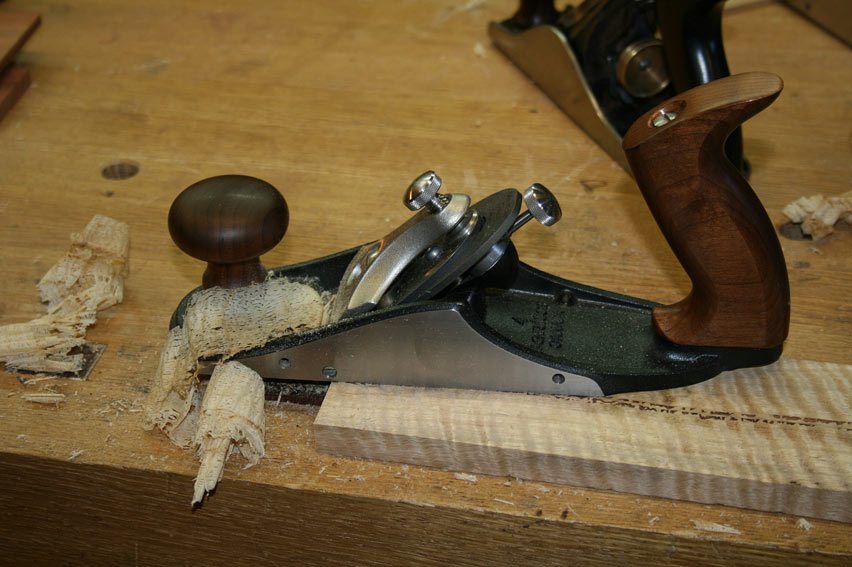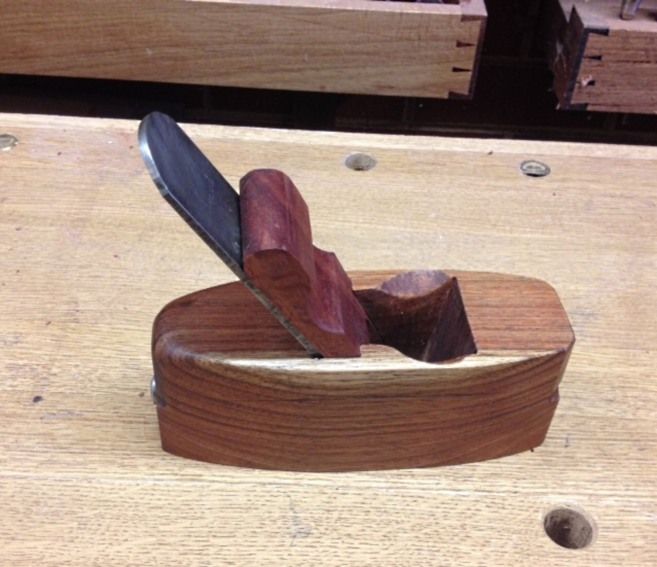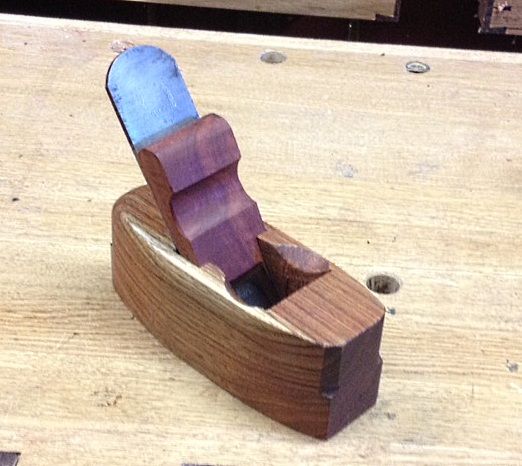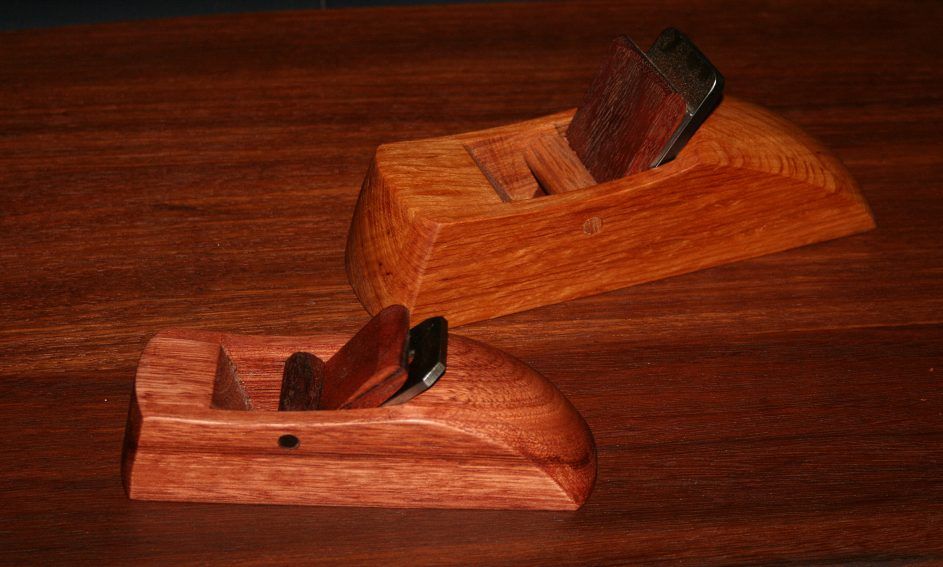 Needs Pictures: 0
Needs Pictures: 0
 Picture(s) thanks: 0
Picture(s) thanks: 0
Results 16 to 30 of 100
-
5th August 2015, 05:29 PM #16

Hi Ray
Sheoak is wonderfully stable. I have done a number of planes in it. I have also done a number in Jarrah .. these timbers were chosen because they are local and available. I think a lot of plane woods start off that way. Beech seems to be the choice in Europe, and probably for that reason spread to the USA, but there is no reason to consider that it is the only material worth using, and that it needs to be imported to Oz. Terry Gordon has a range of timbers on offer, not just because they are beautiful, but because they are stable and hardy.
A comment about Steve's contribution to plane building. This is a Good Thing. What he is offering is very special. It is more than just another wooden plane. It is a well designed (and well-built) wooden plane. The inclusion of a double iron is a significant move forward in a modern woodie. I do not know of one other professional plane maker doing so.
Regards from Perth
DerekVisit www.inthewoodshop.com for tutorials on constructing handtools, handtool reviews, and my trials and tribulations with furniture builds.
-
5th August 2015 05:29 PM # ADSGoogle Adsense Advertisement
- Join Date
- Always
- Location
- Advertising world
- Posts
- Many
-
5th August 2015, 06:23 PM #17

Are most modern woodie smoother's done with single irons ? I haven't looked at any to notice .
99.9 % of the second hand ones are double iron .
The main single iron type seen are the Roughing Plane. JA Walton calls them a German Jack Plane
I have a few owner made local planes made from Blackwood , seems to be OK , looks nice . I don't know if it wears as well .
Rob
-
5th August 2015, 06:25 PM #18

Hi Ray - yes, I think WA she-oak (Allocasaurina fraseriana) should be fine. On average, it's a little bit less dense than our eastern rose she-oak (A. torulosa), and a bit easier to work with. Same observation as for some of our other dense wood; all of the casaurinas are rather fissile, so car would be needed when forming the abuttments to avoid corners breaking off.
For saw handles, the lace stuff is magic! Halfback handle lace she-oak.jpg Handle D-T.jpg
But noit sure it would be good plane-body material as it's a lot more 'crumbly' than the regular stuff. Rose she-oak is one of my favourites for saw handles. It's hard, but fairly easy to work, and takes a lovely finish, which comes up easily, unlike some of the softer woods I've been working with lately. Best of all, I can get it fairly easily for nothing more than a bit of work harvesting it! It has one drawback, and that is you need to be very certain it's bone dry before attaching your blade, this stuff contains a lot of tannins that will chew pits in nice shiny ferrous metal. Of course, that's equally true of many other of our hardwoods. I've tried a couple of tactics to prevent problems, including pouring Lanotec into the slot, and slathering the blade with paste wax before assembly. The paste-wax alone seems to be enough to keep the dreaded rust at bay.....
Cheers,IW
-
5th August 2015, 08:44 PM #19
 Deceased
Deceased











- Join Date
- May 2008
- Location
- Australia
- Posts
- 2,357

A lot of emphasis has been placed on the tests done by Kawai and Katohttps://vimeo.com/41372857 as proof that the best way to manage the impact of reverse grain is use of a 2 piece iron. What they fail to either understand or mention because it doesn't support their argument is the fact that the tests were conducted at a simulated bed angle of 40 degrees. A bed angle more commonly found on Japanese, not Western style Bd Bench Planes; (45, 47.5, 50, and 55 degree's). No woodworker with 1/2 a brain cell would see the merits of tackling reverse grain using a bd single iron bedded at 40 degrees.
Stewie;
-
5th August 2015, 09:01 PM #20

Hi Rob
Who are the major wooden planemakers today? Old Street (formerly Clark & Williams) in the USA. They make 18th woodies but with tapered single irons bedded at either 50 or 55 degrees. Then there is Philly Planes (Phil Edwards in the UK), who makes more modern woodies but still single iron. He is somewhat influenced by HNT Gordon. Of course there is our own Terry Gordon, whose woodies are either 55- or 60 degrees. Fantastic planes, but still single iron. And a new guy on the block in Caleb James, also USA, who has started making moulding and bench planes. All single iron. Lastly, there is Scott Meeks (USA) and David Barron (UK) who build and sell Krenov-style laminated planes for prices higher than the others here, who make solid body planes.
I cannot think of anyone else who is makes wooden planes commercially. And no other that makes a double iron wooden plane than Steve.
Regards from Perth
DerekVisit www.inthewoodshop.com for tutorials on constructing handtools, handtool reviews, and my trials and tribulations with furniture builds.
-
5th August 2015, 09:04 PM #21

Hi Stewie
Meet the 1/2 brain who can plane fiddleback Marri into the grain with 40 degrees and a chipbreaker ...

You really need to get with using the chipbreaker (that is what a double iron is all about) ... No one is suggesting using a 40 degree bed without one. The K and K video did not suggest doing so. Indeed the video presented a reason to do so with the chipbreaker.
No one is suggesting using a 40 degree bed without one. The K and K video did not suggest doing so. Indeed the video presented a reason to do so with the chipbreaker.
Regards from Perth
DerekVisit www.inthewoodshop.com for tutorials on constructing handtools, handtool reviews, and my trials and tribulations with furniture builds.
-
5th August 2015, 09:06 PM #22
 Member
Member











- Join Date
- Jun 2009
- Location
- Holland
- Posts
- 72

When you go back to the original English design, which many regard as very good, then indeed you can't find double iron ones. There isn't much choice anyway. Oldstreet tools have closed their list, because their backorder list was so long. Caleb James makes a few from time to time. Only Philly planes makes these planes in larger numbers, but all are single iron.
Other wooden planes are for example the German ECE planes, which are double iron. The Japanese of course which come in both styles, and HNT Gordon who only makes single iron planes.
So yes, I think Steve's planes are pretty unique at the moment.
-
5th August 2015, 09:07 PM #23
 Member
Member











- Join Date
- Jun 2009
- Location
- Holland
- Posts
- 72

You were typing quicker them me Derek!
-
5th August 2015, 09:13 PM #24

That's me Kees .... Gold .. er .. Fast Finger ...

Regards from Perth
DerekVisit www.inthewoodshop.com for tutorials on constructing handtools, handtool reviews, and my trials and tribulations with furniture builds.
-
5th August 2015, 09:31 PM #25
 Deceased
Deceased











- Join Date
- May 2008
- Location
- Australia
- Posts
- 2,357

Hi Derek. I am not suggesting double irons dont have a place in tackling reverse grain. But its not the only option. Single irons bedded at 47.5 (york pitch) or higher have also been used very successfully of the centuries.
The use of a higher approach angle to tackle reverse grain is not dissimilar to that seen in bu planes.
regards Stewie;
-
5th August 2015, 09:42 PM #26

Of course, Stewie. I have never said otherwise. For many years I have championed high angle planes, both BU and BD. They can all work. So does the low angle BD with a chipbreaker set close. All just options. Having said this, I am not a fan, nor have ever been one, of high angle BD planes, unless they are narrow bodied, since they require more effort to push. A plane with a lower bed (such as a common angle) will always be easier to push that a plane with a higher bed (hence the advantage of adding the chipbreaker). BU planes, on the other hand, with a low centre of gravity, seem more immune to this issue.
Regards from Perth
DerekVisit www.inthewoodshop.com for tutorials on constructing handtools, handtool reviews, and my trials and tribulations with furniture builds.
-
5th August 2015, 10:04 PM #27
 Deceased
Deceased











- Join Date
- May 2008
- Location
- Australia
- Posts
- 2,357

Hi Derek . It seems we share a common passion for high bed single iron planes. http://www.inthewoodshop.com/ToolRev...g%20Plane.html
Stewie;
-
5th August 2015, 10:34 PM #28

Hi Stewie
The HNT Gordon smoother is one of those excellent planes that just works. What makes it a good plane is that it has a very low centre of gravity and centre of effort. It is also different in the way it is pushed. It is far from the typical high bed woodie - I would not use this as evidence that high angle woodies are all good and supported by me. I think that you are trying to justify something in this regard.
This plane does not get as much use in my workshop as other smoothers since it is not particularly comfortable to push holding the body, which is not how it is designed to be used, and using the (Chinese style) handles is not really my thing. It is capable, nevertheless, of high performance.
The HNT Gordon Trying Plane came in for modifications for this very reason. The story is here: http://www.inthewoodshop.com/Comment...fortPart2.html

I have made many wooden smoothers. Here is a classic coffin style with a 55 degree bed ..


Truthfully, while it performs well enough, I dislike the plane since it feels awkward and lacks the control of a lower plane, such as this Krenov (also with 55 degree bed) ..

Incidentally, Ian, that is one of the She-oak planes I have built.
Any further wooden smoothers I build will be double iron.
Regards from Perth
DerekVisit www.inthewoodshop.com for tutorials on constructing handtools, handtool reviews, and my trials and tribulations with furniture builds.
-
5th August 2015, 10:49 PM #29
 Deceased
Deceased











- Join Date
- May 2008
- Location
- Australia
- Posts
- 2,357

For me there is something quite evocative about these planes. They are fine performers - up there with the best. They are relatively inexpensive – certainly less than others in their performance bracket. Those are good qualities but not the ones that draw me back to these planes time and again. I like the warmth of the wood from which they are made. I like the way the planes glide over timber surfaces. I like the ease of honing their blades. I like the way they look. I even like the way they are held and the history to which they are linked. I just like these planes. http://www.inthewoodshop.com/ToolRev...g%20Plane.html
Derek Cohen
Hi Derek. You seemed to have changed your opinion after doing the original review.
Stewie;
-
5th August 2015, 11:06 PM #30

Stewie, that review was written in January 2007. That is 8 1/2 years ago! I would not say that I have changed my opinion (that the HNT Gordon planes are good). What has changed has been my methods of using planes, and my experiences over time. We move on.
What point are you trying so very hard to make?
Regards from Perth
DerekVisit www.inthewoodshop.com for tutorials on constructing handtools, handtool reviews, and my trials and tribulations with furniture builds.
Similar Threads
-
Videos the making of a Double Iron try plane
By D.W. in forum Saws- handmadeReplies: 8Last Post: 23rd June 2018, 09:18 AM -
Money maker wooden toy
By srulik in forum TOY MAKINGReplies: 2Last Post: 26th July 2011, 07:30 PM



 Thanks:
Thanks:  Likes:
Likes: 
 Reply With Quote
Reply With Quote
